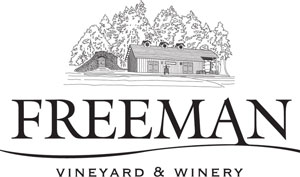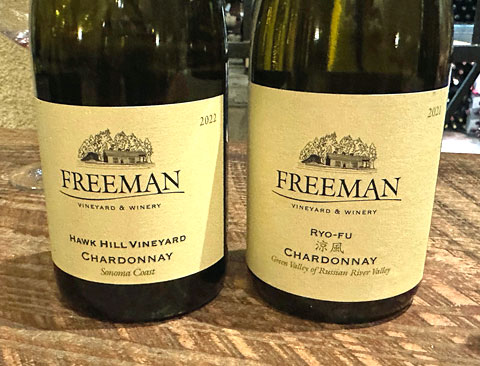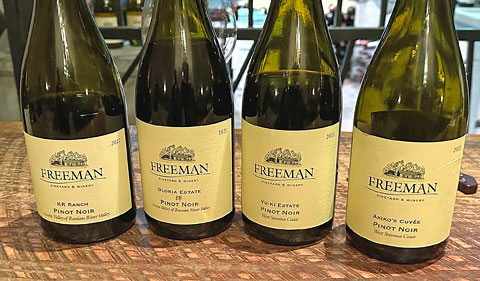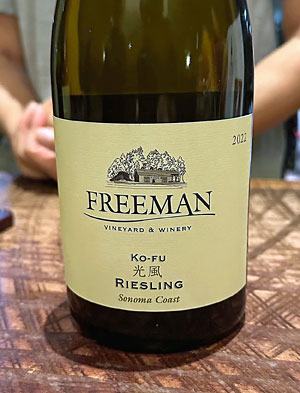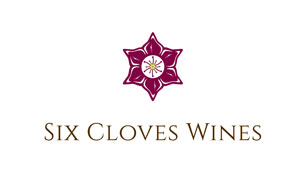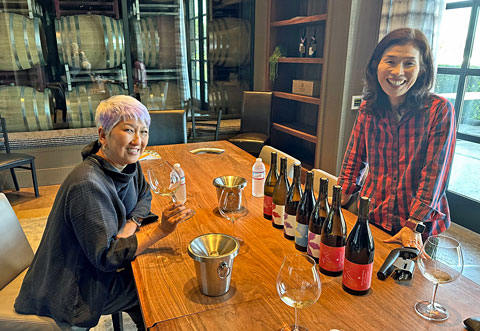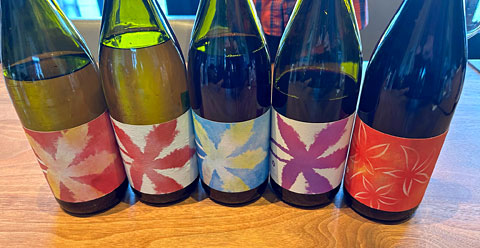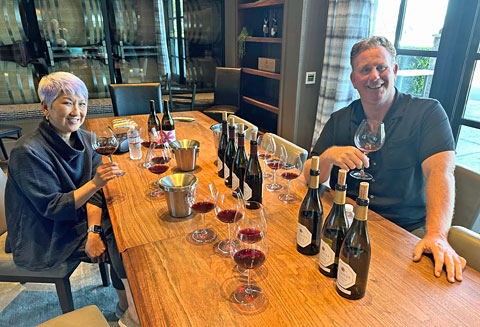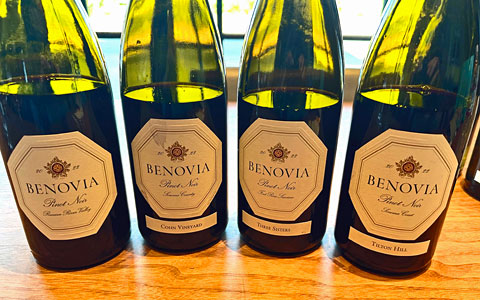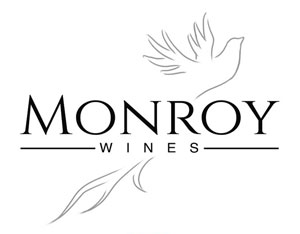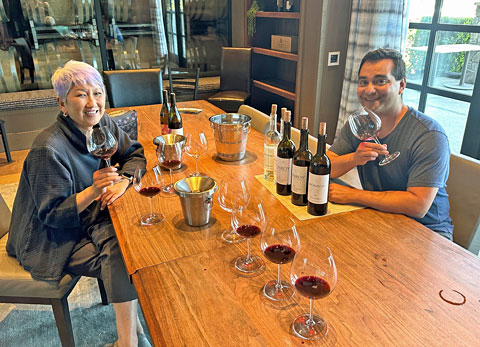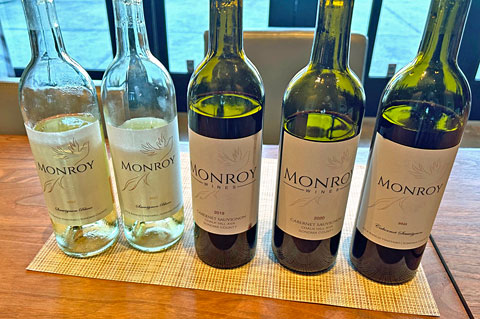Russian River Valley Wineries - August 2024
Although Russian River Valley is not a particularly long drive from where I live in Oakland, it had been awhile since I’d done any wine-tasting in that area. There were a few vintners I wanted to visit, and my friend Jane was interested in joining me for a day-trip. It turned out that our busy schedules pushed the date for our trip to late August. That’s a tricky time for winery visits since many wineries are getting ready for harvest and crush – or have already started. I contacted some winemakers I know in the area and was able to schedule visits with a couple of them. I thought it would be just a two-visit day, which would have been fine, but one of the vintners we would be visiting managed to arrange for two additional winemakers at the same facility where she works to pour their wines for Jane and me. That turned out to a very convenient way to talk with three vintners and taste wines from three labels all at one winery!
I picked up Jane in San Francisco and then proceeded across the Golden Gate Bridge and through Marin County to Sonoma County, eventually heading west from the town of Sebastopol where we soon reached our first winery destination.
| Thursday
- August 22, 2024 |
Freeman Vineyard & Winery
Our first stop of the day was at Freeman Vineyard & Winery, and it was only a moment after I parked the car there that winemaker / co-owner Akiko Freeman waved hello from outside the winery. I’ve known Akiko for a number of years, and I’ve been able to help with bottling the Freeman wines several times over the past year or so but hadn’t tasted most of their current wines. Akiko’s husband Ken is originally from Scarsdale, New York, and the couple first met when in 1985 when Hurricane Gloria disrupted a sailing trip that Ken was taking with friends and they instead went to a another friend’s keg party. Akiko was then a college exchange student from Tokyo and happened to have been invited to the same party. Having arrived in the US only recently, she wasn’t familiar with the idea of a keg party, so she came attired in a beautiful formal dress – Ken couldn’t help but notice her!
Akiko and Ken discovered that they shared a love of wine, particularly the wines of Burgundy. Akiko went on to earn a master’s degree in Italian Renaissance art history from Stanford, while Ken became a private equity banker after earning an MBA degree at Northwestern University. The couple eventually gained an interest in starting their own winery, and they were able to purchase a three-acre property outside of Sebastopol in 2001, in the Green Valley of Russian River Valley AVA. Ideally for them, a large barn on the site had already been used by a previous owner as a winery. They added a wine cave a couple of years later, dug into the hillside behind the barn, and they also purchased an adjacent property that had been an old apple orchard. Akiko and Ken planted vines there in 2006, and they named the vineyard Gloria for the hurricane that had brought them together. Not long afterwards, they bought a former sheep ranch property and planted that in 2007 – this is Yu-ki Vineyard, at about 1,000-foot elevation near the small town of Occidental and within the new West Sonoma Coast AVA. Yu-ki means “courage” or “giant tree,” a fitting name given the redwood forest surrounding the hillside vineyard. It’s also the name of Akiko’s nephew, whom she hopes may take over the winery someday.
The two current estate vineyards are farmed using organic methods and are planted almost entirely to Pinot Noir. They include a number of different Pinot clones – both Dijon clones and California heritage selections such as Swan, Calera, and Mt. Eden are planted. Akiko told us that they have been working toward organic certification for the eight-acre Gloria Estate vineyard, gradually restoring the soil health of the former apple orchard. The site features the area’s well-known Goldridge soil. The 14-acre Yu-ki Vineyard is on clay and sandy loam soil, and has been farmed organically from the start. Akiko and Ken are working to develop a third estate vineyard, on an 11-acre site between Sebastopol and Freestone – they have some ideas for a vineyard name but haven’t yet decided on one. The site had been an apple orchard, and they’re planning to plant about nine acres, with about half of it Chardonnay and the rest Pinot Noir and Riesling. Akiko said they expect this to be around a five-year project, and as with the other estate vineyards it will be farmed organically.
The focus of Freeman from the start has been on Chardonnay and Pinot Noir, and the first vintage was from 2002. Noted vintner Ed Kurtzman has been part of the Freeman winemaking team from the start, and he’s worked closely with Akiko. Akiko has been making the wines herself since 2010, while Ed has stayed on in a consulting role. Eiji Akaboshi is the associate winemaker, and we saw him getting the winery press ready for harvest and crush, which would be starting for them just a few days after our visit. The Freeman winemaking style can be described as minimalist and light-handed – Akiko’s goal is to emphasize the terroir and vintage in the wines. Chardonnays are made in little to no new oak, and while the Pinots are aged in some new French oak barrels, the percentage of new oak is less than that used at many wineries.
There have been some exciting events for Freeman this year. Akiko and Ken were on hand as two of their wines were served this April during a luncheon at the State Department in Washington DC, at an official event hosted by Vice President Kamala Harris to celebrate the visit of Prime Minister Fumio Kishida of Japan. And also this year, Akiko was presented with a Women in Wine Excellence in Winemaking Award from the North Bay Business Journal.
Akiko led Jane and me into the wine cave to taste some of the Freeman wines with her there. The caves are about 6,000 square feet in size and can fit up to 500 barrels. A handsome wooden slab set on top of wine barrels serves as a tasting counter at the central part of the caves. We started our tasting with the 2022 Hawk Hill Vineyard Chardonnay. The vineyard is in a very cool-climate Sonoma Coast location near Freestone, and Akiko told us that it’s always the last of their fruit to be harvested each year. The wine was fermented and aged in neutral French oak barrels. This had subtle apple, citrus, and spice aromas plus floral notes, with a bright mouthfeel and vibrant finish. Next was the 2021 “Ryo-Fu” Chardonnay, which is sourced from Heintz Ranch near Occidental and from Dutton Ranch Shop Block near Graton, both in the cool western Russian River Valley. Appropriately, the name of this wine is Japanese for “cool breeze.” The wine featured pear and stone fruit on the nose, combining a somewhat richer texture with good acidity and a long finish.
We moved on to taste four different Pinot Noir bottlings. The first of these was the 2022 KR Ranch Pinot Noir, made from 777 and 23 Mariafeld Pinot clones. This bottling used to be labeled as Keefer Ranch, but since management of the property changed hands awhile back, Freeman came up with a new designation for the vineyard name. Displaying intense floral aromatics along with fresh red fruit and spice, this was a lighter-weight Pinot with a lively, flavorful finish. The 2021 Gloria Estate Pinot Noir is from the Dijon 115 Pinot clone plus four California heritage selections – Swan, Martini, Calera, and Pommard. This showed a darker fruit profile than the previous wine, with black cherry and plum notes plus earth and spice, with medium body and a long finish – a subtle and elegant rendition of Russian River Valley Pinot.
Akiko continued with the 2021 Yu-ki Estate Pinot Noir. In this vintage, every Pinot clone grown at the vineyard is included in the wine – Calera, Mt. Eden, 2A Wadenswil, 23 Mariafeld, 114, 667, and 828. The wine featured a more savory side of Pinot, with herb and tea leaf notes along with black cherry and a touch of spice, medium weight on the palate and good structure with a bit more tannin on the finish than the first two Pinots. Our final Pinot was the 2021 “Akiko’s Cuvée” Pinot Noir. This wine is a barrel selection that’s been made every year since Freeman’s inaugural vintage. Akiko and her winemaking staff each create their own blend and they taste them all to determine a favorite – Akiko’s blend almost always wins! Akiko told us that this wine is meant to be an approachable and fun Pinot that doesn’t need aging yet will develop more complexity with time in the cellar. Very aromatic, with black cherries, flowers, and a touch of vanilla/oak, medium body with lively acidity and fine tannins.
As Jane and I talked with Akiko, I asked about Freeman’s new Riesling, which they produced for the first time in the 2022 vintage, and Akiko graciously opened a bottle of the 2022 “Ko-fu” Riesling for us to taste. Akiko described the wine’s name as a Japanese word meaning “a spring breeze which brings a spring flower aroma and fresh green scent.” The fruit was sourced from Abigail’s Vineyard, directly across the road from the Freeman winery. As with the Freeman Chardonnays, this was barrel-fermented in neutral French oak, and malolactic fermentation on the Riesling was blocked to help preserve the wine’s vibrant acidity. Subtle aromas of citrus and stone fruit, herbs, and a touch of Riesling petrol, with zippy acidity on the palate and a clean, dry finish – nice now but worth cellaring.
Other Freeman wines that we didn’t taste on this occasion include Russian River Valley Pinot Noir, West Sonoma Coast Pinot Noir, plus sparkling wines Yu-ki Estate Blanc de Blancs and Yu-ki Estate Rosé Brut. Akiko mentioned that former Schramsberg winemaker Craig Roemer is their consultant for sparkling wines. Total annual production for the Freeman wines is around 5,000 cases.
It had been nearly five years since my most recent tasting with Akiko at Freeman so this was a good opportunity to try many of the current bottlings. Always some of the most elegant Chardonnays and Pinot Noirs from this region, I think the wines display even more subtlety and refinement now. Both the Chardonnays and Pinots showed great distinctiveness between the different bottlings. It was tough to pick out particular standouts among this strong wine lineup, but the 2022 Hawk Hill Vineyard Chardonnay, 2022 KR Ranch Pinot Noir, 2021 Yu-ki Estate Pinot Noir, 2021 “Akiko’s Cuvée” Pinot Noir, and 2022 “Ko-fu” Riesling were my favorites. Tasting at Freeman is by appointment, and I highly recommend visiting there if you’re in this part of wine country.
Underwood Bar & Bistro in the small town of Graton has long been one of my favorite dining destinations in this part of Russian River Valley, and since it was about midway between Freeman and our next winery appointment it was a convenient place to stop for lunch. Their hamburger is always a good choice, and Jane ordered one, though since I’d had that several times before, I decided to try their BLT. That had applewood-smoked bacon, romaine lettuce, local tomatoes, and basil aioli on toasted sourdough, and it came with fries. The sandwich was larger than I expected, and there was a huge helping of fries, more than I could finish. The BLT was delicious, and the tomato in particular was fantastic, super-flavorful. Jane and I had enough time to enjoy a relaxing lunch at Underwood before heading out to our afternoon winery visit. It wasn’t too long a drive to Benovia Winery, on the northwestern outskirts of Santa Rosa off of Piner Road, where we were scheduled for tastings with winemakers for three different labels.
Six Cloves Wines
The idea for this one-day wine tour with Jane in Russian River Valley started with the opportunity to taste some Six Cloves wines with owner / winemaker Sonoe Hirabayashi. I’ve known Sonoe for a few years but only tasted her wines for the first time earlier this year, so I was interested in trying more of them and in introducing the wines to Jane as well. We’d originally arranged to taste with her while we were visiting Freeman, where Sonoe has worked during crush the past couple of years, but a few days before our appointment she suggested tasting at Benovia Winery instead, as that’s where she’s working during this year’s crush season. I hadn’t been to Benovia for a number of years and had a little difficulty finding the place where Sonoe had arranged for our tasting, but it didn’t take too long for Jane and I to locate it. Sonoe saw us outside and welcomed us into a room with a long table inside of the large winery building, with a beautiful view of one of Benovia’s estate vineyards. After she gave us a quick tour of the winery building, Sonoe led us back into the room and we sat down to taste some of her Six Cloves wines.
Sonoe is originally from Nagano, Japan, and she worked for a number of years for a Japanese import/export business in New York City. Although she was successful there, she felt unfulfilled in that job. While in New York, Sonoe developed a passion for fine wines and learned that she had a very good palate. Her father was a highly-regarded apple grower, and her family has a generations-long background of producing sake, soy sauce, and miso – this family history is part of what led her to consider changing her career to one in the wine business. After seeing an article in Wine Spectator magazine about the UC Davis wine program she decided to apply there – she was accepted and earned a degree in viticulture & enology in 2011.
From the start, Sonoe was determined to follow a path to becoming a winemaker and to start her own wine label. She sought out highly-regarded vintners whom she felt she could learn from, to supplement her academic knowledge of wine science from UC Davis with the more intuitive and artistic side of winemaking. California vintners that Sonoe worked with along the way have included Ted Lemon at Littorai and Steve Matthiasson, and she spent Southern Hemisphere harvests working in New Zealand and Chile as well.
It was while Sonoe was working with Steve Matthiasson that she launched her Six Cloves wine label in 2017 with a Russian River Valley Chardonnay. The idea for her label name came from the business of a centuries-old ancestor who had sold medicinal herbs and spices – the logo of that business featured six cloves. Sonoe had a graphic designer friend create the elegant logo of her winery from that concept.
Sonoe has crafted her wines with the idea of making them food-friendly. She’s noted that her palate sensitivities, from her upbringing in Nagano, are different from those of most American winemakers – she said that her wines pair quite well with Japanese food though that’s not been her specific intent. To date, Sonoe has sold most of her small production of Six Cloves wines in Japan – she currently makes only around 300 cases per year. She said that it’s been a bit more difficult to gain a foothold in the crowded US wine market, particularly during the pandemic years. But since many of her wines are purposefully distinctive – not the typical California renditions of the varieties she works with – she feels optimistic. Sonoe’s wines display a light touch, with minimal winemaking intervention, and she’s now buying fruit only from organically-farmed vineyards. All of the Six Cloves wines undergo native fermentation and though some wines are aged only in older barrels, Sonoe uses some new French oak when she feels a wine will benefit from the additional complexity that can help bring. Whites are direct-pressed and barrel-fermented while some reds have a percentage of whole-cluster fermentation.
Sonoe started our tasting with her 2021 Alder Springs Vineyard Chardonnay. The vineyard is near Laytonville, at higher elevation not far from the Pacific coast in far northern Mendocino County – it must be one of the most remote vineyard sites in California. Grower Stuart Bewley farms about 150 acres of grapevines there, including some varieties that are rarely seen anywhere else in the state. The wine, made from Chardonnay clones 76 and 95, was fermented and aged in second-year and older French oak. This displayed citrus and pear aromas with undertones of flowers and stony minerals, with vibrant acidity and a long, fresh finish. The 2022 Linda Vista Vineyard Chardonnay comes from a vineyard in the cooler Oak Knoll District of Napa Valley – it was originally planted by Beringer in the 1980s and has been farmed organically for a number of years by Steve Matthiasson. There’s about 20% new French oak on this Chardonnay, made from the Olmo clone of the variety. Showing more of a stone fruit and spice profile than the previous wine, this had a broader mouthfeel with fine acidity.
We moved on to red wines, beginning with the 2021 Alder Springs Vineyard Pinot Noir. The wine was made from the 459 clone of Pinot, not seen much in California. The fruit was fermented with 50% whole clusters and the wine was aged in neutral French oak barrels for 10 months. This had a light color with intense floral and savory herbal aromas along with red fruit and earthy notes, lively acidity on the palate, and fine tannins on the long finish. Although we didn’t taste it on this occasion, I want to mention the Six Cloves 2022 Buf-Wehr Ranch Pinot Noir that I tasted at a wine event in April. Sourced from a Russian River Valley vineyard, this is from Pommard clone, and as with the previous wine it was 50% whole-cluster fermented before aging in neutral French oak. My notes from that earlier event said that this wine “was very aromatic, with flowers and bright fresh red fruit, along with medium body and a lively mouthfeel and finish.”
Jane and I tasted two more reds with Sonoe. The 2022 Castanon Vineyard Zinfandel comes from a site in Mendocino County’s Redwood Valley. Most Zinfandels are entirely destemmed prior to fermentation but this was fermented with about 30% whole clusters, and the wine was aged in 20% new French oak. With lighter color and more intense aromatics than most Zin, this was very distinctive, with bright raspberry, spice, and dried herb notes, a lively texture and moderate tannins. Our final Six Cloves wine was the 2019 “Magnolia” – this is a blend of 50% each Cabernet Sauvignon and Merlot, sourced from two vineyards in the cool Napa Carneros region and farmed by two of Sonoe’s UC Davis classmates, Shaunt Oungoulian and Diego Roig. The fruit was entirely destemmed and then each variety was fermented and aged separately for nine months (in second-year and older French oak) before blending. The wine featured subtle herbal notes plus darker berry fruit, earth, and spice, with medium body and good structure for continued development in the cellar.
Looking to the future, Sonoe may get more Cabernet fruit from Shaunt and Diego – to date, the 2019 “Magnolia” is the only wine she’s made from the vines they’re farming – and fruit from the West Sonoma Coast is another possibility. She also told me that next year she may be getting some “interesting whites” from Alder Springs Vineyard – can’t wait to find out more about that!
Sonoe had other work to attend to so it was a short tasting with her. But she had graciously arranged two additional tastings for Jane and me while we were at the Benovia facility, so we remained there for the next one. We knew that the next two tastings would be quick ones as well and joked that it was like the wine-tasting equivalent of speed dating!
This was a fun tasting with Sonoe – I’ve been wanting to visit with her and taste more of her wines for awhile so I was glad that we were able to get in this visit just on the cusp of this year’s winegrape harvest and crush. Sonoe presented a very nice group of her Six Cloves wines, with all of them displaying a subtle winemaking touch and fine balance – on the lower side for alcohol, yet lively and flavorful but not too lean. They show somewhat different renditions of California wines, so they’re both familiar and distinctive. I enjoyed all of the wines that Sonoe poured for us, and my favorites were the 2021 Alder Springs Vineyard Chardonnay, 2021 Alder Springs Vineyard Pinot Noir, 2022 Castanon Vineyard Zinfandel, as well as the 2022 Buf-Wehr Ranch Pinot Noir I’d tasted a few months earlier. The wines are mainly available through the Six Cloves website, and tasting with Sonoe can be arranged by appointment. It’s always exciting to see a relatively new vintner get off to such a strong start, and I’m looking forward to following the Six Cloves wines in the coming years.
Benovia Winery
Jane and I were scheduled for three brief tastings while we were at Benovia Winery, and our next one was with Benovia winemaker Mike Sullivan. I’d met Mike and tasted with him years before, but it had been some time since I’d tried the wines, so this was a great opportunity to do so. Benovia was founded in 2005 by husband and wife Joe Anderson and Mary Dewane – they combined the names of their fathers, Ben and Novian, to form the name of their winery. Mike is also a co-owner of Benovia and has been their winemaker from the start. He grew up in Sonoma County – his family owns a vineyard, Four Brothers, on the slopes of Sonoma Mountain. Mike began working at local wineries while he was still a teen, and earned an enology degree from Fresno State University in 1993. He worked for Helen Turley at Landmark in Sonoma Valley and at Chappellet in Napa Valley, and then became the winemaker of Hartford Family Winery in Russian River Valley for a number of years before coming to Benovia.
The origins of Benovia actually go back further than 2005 – owners Joe and Mary, both in the health care business at that time, purchased the 18-acre Cohn Vineyard in 2003. This site includes what may be the oldest Pinot Noir plantings in the region, with some vines (probably Pommard and Martini clones) dating from 1970, as well as Zinfandel. In 2005 the couple bought a vineyard and winery property from Cecil De Loach – the site where Benovia is now located – and then more adjacent property in 2008. This is now the 42-acre Martaella Estate Vineyard, named for the owners’ mothers Martha and Eleanor and planted mainly to a variety of Chardonnay and Pinot Noir clones, with some of the older vines there dating to the 1990s. A third estate vineyard, Tilton Hill, is on a ridgetop near Freestone in the Sonoma Coast AVA, and was planted in 2009. With the region’s famous Goldridge soil, 12-acre Tilton Hill is planted mostly to California heritage clones of Chardonnay and Pinot Noir. The vines that Benovia planted at both Martaella and Tilton Hill use dense 5-foot by 4-foot spacing. Altogether, Benovia owns and farms about 72 acres on its three estate vineyards – they harvest about half of their estate fruit for their own wines and sell half to other vintners. All three estate vineyards are organically or sustainably certified, and they’re farmed by longtime vineyard manager Chris Kangas.
Benovia also sources Chardonnay and Pinot Noir fruit from a couple of other sites. The Martinelli family’s Three Sisters Vineyard is in the Fort Ross-Seaview appellation of the West Sonoma Coast, with about 30-year old vines, while their Zio Tony Vineyard, first planted in 1990, is in western Russian River Valley. Benovia also gets some Grenache from Four Brothers Vineyard owned by Mike Sullivan’s family, and from a couple of other sites as well. These vineyard sources, along with Benovia’s three estate vineyards, give them a great diversity of climates and soils for the vines, which helps the wines show distinctive character between the various sites.
Fruit for the Benovia Chardonnay and Pinot Noir is picked at night to help ensure that it’s still cold when it reaches the winery. Chardonnay clusters are sorted first, then direct pressed, after which the juice is settled in stainless steel tanks before racking to barrels, where it undergoes native fermentation. The Chardonnay lees is stirred in barrel until malolactic fermentation is complete. Pinot Noir clusters are sorted prior to destemming, and then there’s an additional sort of individual berries prior to fermentation. Some Pinot fruit is fermented with whole clusters, and as with the Chardonnay, all of the Pinot Noir is fermented with native yeast. Single vineyard Chardonnays and Pinot Noirs are typically barrel-aged for around 14-16 months before bottling. This amount of time in barrel means that the winery has to be large enough to accommodate barrels from two vintages at the same time. The Benovia owners have made the commitment to providing the space necessary for Mike and his winemaking team to give the wines the barrel age he feels will allow them to show their best.
I should mention the handsome winery building that we were in – work on this and on the nearby tasting room was completed in 2015. Designed for Benovia’s red wine production, the winery building is around 10,000 square feet and includes two rows of stainless steel tanks and plenty of room for barrels. Benovia also has its own in-house bottling line, something not often seen in a winery of this size, and it allows greater flexibility for when wines are bottled.
Mike brought to the table three Benovia Chardonnays and four Pinot Noirs, all from the 2022 vintage. He also set out four wine glasses each for Jane and me so that we could compare the wines more easily. We started with the 2022 Russian River Valley Chardonnay – this was sourced mostly from the Martaella and Tilton Hill Estate Vineyards, and largely features the Old Wente and Mt. Eden heritage Chardonnay clones that Benovia planted at those sites. The wine was made in about 25% new French oak with around 11-12 months in barrel. It displayed pear and stone fruit aromas with floral and spice undertones, medium body, and a pleasant finish.
We also tasted two of the 2022 single-vineyard Estate Chardonnay bottlings. The 2022 Martaella Estate Vineyard Chardonnay was aged in a bit more new French oak – about 35% – and spent 15 months in barrel prior to bottling. This had more of a citrus fruit profile plus touches of spice and vanilla oak, with a bit richer mouthfeel and finish. The 2022 Tilton Hill Estate Vineyard Chardonnay, from Mt. Eden and Old Wente Chardonnay clones, was made in the same way as the previous wine, and comparing them side by side really highlighted the difference of the vineyard sources. The wine featured more intense aromatics, with citrus, flowers, and subtle spice and oak notes, combining medium weight on the palate with vibrant acidity.
Moving along to Pinot Noirs, we started with the 2022 Russian River Valley Pinot Noir – this is a blend from the three estate vineyards, with around 40% Martaella, 55% Tilton Hill, 5% Cohn, and was fermented with about 20% whole clusters. With intense black cherry, spice, and floral aromas, this had medium body with fine tannins on the finish. Mike noted that the 2022 vintage had particularly low crop yields, with generally smaller berries that resulted in more intense wines that display greater density than usual.
We followed the Russian River Valley appellation Pinot with three 2022 single-vineyard bottlings – these typically range from around 15-40% whole-cluster fermentation. The first of these was the 2022 Cohn Estate Vineyard Pinot Noir, which showed a riper fruit profile plus notes of herbs and a touch of vanilla/oak, a bit richer mouthfeel and good structure for development in the cellar. Next was the 2022 Three Sisters Vineyard Pinot Noir, made entirely from Pommard clone. This was quite savory, with tea leaf, earth, black cherry, and a subtle floral note, with a medium-rich mouthfeel plus fine acidity and structure. Our final Benovia wine was the 2022 Tilton Hill Estate Vineyard Pinot Noir – this had black cherry and plum fruit aromas along with an even more savory character, with spice and earth notes plus undertones of vanilla/oak, great texture and fine structure. All three single-vineyard Pinots are tasty now but should be age-worthy as well.
Benovia makes a number of other wines that we didn’t taste with Mike on this occasion. These include Rosé of Pinot Noir, Martaella Estate Vineyard Sauvignon Blanc, Blanc de Noir Sparkling Wine, Three Sisters Vineyard Chardonnay, “La Pommeraie” Chardonnay and Pinot Noir bottlings (both from Zio Tony Vineyard), Martaella Estate Vineyard Pinot Noir, Sonoma County Zinfandel, Sonoma Mountain Grenache, Cooley Vineyard Cabernet Sauvignon, Oakville Cabernet Sauvignon, and other limited-release bottlings. One more I should note is their 2022 “Good Press” Pinot Noir, which helps to provide funding for the Santa Rosa Press Democrat Journalism Trust, a nonprofit organization whose goal is to preserve and advance local journalism through scholarships, internships, and work opportunities. Total annual production for Benovia is around 6,000-7,000 cases, and about 70% of the wines are sold direct to consumers.
It had been way too long since my last tasting at Benovia so being able to try many of the current bottlings with Mike was a great bonus for our day of wine-tasting in Russian River Valley. The wines maintain a welcome middle ground between the bigger, riper style and the overly lean style. While there’s plenty of fruit in the Benovia Chardonnays and Pinot Noirs, there’s more going on than just the fruit in all of the wines – floral, earthy, savory, and other elements are there to balance the fruit as well as good acidity for a fresh character throughout the wine lineup. And while a touch of oak is present in these wines, it’s understated and well-integrated. I enjoyed all of the wines that Mike poured for us, and particular favorites included the 2022 Russian River Valley Chardonnay, 2022 Tilton Hill Estate Vineyard Chardonnay, 2022 Three Sisters Vineyard Pinot Noir, and 2022 Tilton Hill Estate Vineyard Pinot Noir. A range of tasting options are available at Benovia, and a stop there should be on your list of Russian River Valley winery visits.
Monroy Wines
The last of our three brief tastings at Benovia Winery was with Adolfo Hernandez, the owner / winemaker of Monroy Wines. Adolfo had poured his wines at a tasting event a few months earlier and I’d hoped to check them out but ran out of time and wasn’t able to try them there, so I was glad to be able to taste them on this occasion. Adolfo and his family lived in Saudi Arabia when he was growing up, and though alcohol was banned there, the closed American expat communities were given some leeway and a number of people there would make their own bootleg wine – Adolfo remembers helping his father make wine in plastic carboys from bottled grape juice. He moved with his family to California in 1997, and Adolfo attended Cal Poly San Luis Obispo where he earned a degree in molecular biology. After a few years, he gravitated toward the wine industry, where his background led him to a position in the wine lab at Clos du Bois in 2006. Since then, Adolfo has worked at a number of highly-regarded wineries including Eisele, Checkerboard, and Pahlmeyer in Napa Valley before coming to Benovia – he’s now starting his eighth harvest there, and he’s currently Benovia’s associate winemaker.
Adolfo and his wife Nohelia launched their own Monroy label with a Cabernet Sauvignon from the 2018 vintage, and they’ve added Sauvignon Blanc starting with the 2022 vintage. The winery name comes from Adolfo’s full name, Adolfo Hernandez de Monroy, and as an homage to his Guatemalan heritage, the bottle labels feature the image of a Quetzal, the country’s national bird. While he makes mostly Chardonnay and Pinot Noir in his position at Benovia, he produces only Sauvignon Blanc and Cabernet Sauvignon for Monroy, being very familiar with those varieties from his earlier work with Napa Valley wineries. Through 2020 – the current Monroy Cabernet vintage – Adolfo sourced his fruit from the Chalk Hill AVA in Sonoma County, but starting with 2021 he’s been getting all of his fruit, both Sauvignon Blanc and Cabernet Sauvignon, from Kick Ranch Vineyard. Located in Sonoma County’s Fountaingrove District AVA and initially planted in 2000, the hillside vineyard is on the western slope of Spring Mountain. It has a cooler climate than the eastern (Napa) side of Spring Mountain, and that’s something that Adolfo has consistently looked for in his vineyard sources.
Though he helped make some bolder wines when he worked in Napa Valley, Adolfo’s goal for Monroy is to make a more restrained style of wine that highlights savory and floral elements along with natural acidity. The combination of cooler vineyard sites, harvesting on the earlier side, and winemaking techniques all help in this respect. For his Sauvignon Blanc, Adolfo uses only the naturally floral Musqué clone for his Monroy wines. The fruit is direct pressed and made in both barrique and hogshead French oak barrels as well as stainless steel. A small percentage of new oak was used for both the 2022 and 2023 vintages, and Adolfo told us that the 2024 vintage of his Sauvignon Blanc will have no new oak. The wine is aged on the lees to help build more mouthfeel.
For the Monroy Cabernet Sauvignon Adolfo uses the labor-intensive method of barrel fermentation. He removes the barrel heads, adds the destemmed fruit, and closes the barrels again. They’re placed onto racks with special rollers so instead of typical punchdowns or pumpovers in larger fermentation vessels, the vented barrels are rolled in place for cap management. After fermentation is completed, Adolfo opens the barrels again, drains out the wine, removes the grape skins, and then fills the barrels once more, this time with the wine which is then aged for about 18-20 months prior to bottling. He uses only French oak, with around 50% new barrels. The barrel fermentation technique helps integrate the oak into the wine and adds greater texture that you often find in bigger Cabernets but without the overly ripe character and higher alcohol of those wines.
Both the Sauvignon Blanc and Cabernet Sauvignon are small-lot, low-production wines, and total annual production for the Monroy wines is only about 350 cases. Adolfo said that he currently sells about 50% of his wines direct to consumer and 50% via various trade accounts, and that he’d like to eventually keep a production level of around 500 cases per year. He plans to continue his focus on making only Sauvignon Blanc and Cabernet Sauvignon in the future.
Adolfo started Jane and me with tasting his Sauvignon Blanc from two vintages. The 2022 Kick Ranch Vineyard Sauvignon Blanc was fermented and aged in 15% new French oak, 25% neutral oak, and 60% stainless steel, spending about six months on the lees prior to bottling. This was quite floral on the nose, along with citrus and tropical fruit notes, and combining medium body with fine acidity and a clean finish. The 2023 Kick Ranch Vineyard Sauvignon Blanc had similar fermentation and aging to the 2022 vintage, with a little more time on the lees. With even more intense fresh stone fruit and tropical fruit plus floral aromas, this shared a similar texture and bright finish with the previous wine.
We moved on to three vintages of the Monroy Cabernet Sauvignon, all barrel-fermented. The 2019 Chalk Hill Cabernet Sauvignon was first. This featured currant and darker fruits, savory herbs, and undertones of pepper and oak, with medium-full body, fine structure, and a lively mouthfeel and finish. As with the 2019 release, the 2020 Chalk Hill Cabernet Sauvignon was sourced from a higher-elevation site within the appellation. A bit riper and bolder in profile than the previous wine, this showed more spice and vanilla/oak along with dark berry fruit and more tannic grip on the finish. Our final wine was the 2021 Kick Ranch Vineyard Cabernet Sauvignon from Adolfo’s new Cabernet fruit source in the Fountaingrove District. Displaying both red and black fruits, spice, and dried herbs on the nose plus undertones of flowers and stony minerals, this had both moderate richness and a lively texture on the palate along with good acidity and fine tannins – I think this has the potential to become the most complex of the three Cabernets. All three of the Monroy Cabernets are still quite young and deserve time in the cellar to more fully develop their fine potential.
Our tasting with Adolfo was a fun though fairly brief one, as he needed to get back to work – he told us that Benovia was bringing in their first fruit of the 2024 harvest the following day so he needed to prepare for that. The Monroy wines present a more elegant and refined take on the typical California renditions of their two varieties, particularly with regard to the Cabernet Sauvignon. While they’re not quite a “throwback” style, they’re definitely not in the big, ripe style of so many California Cabernets – there’s great balance to all of the Monroy wines, and it’s clear that the Cabernets are built to develop with aging rather than being immediate blockbusters. My favorites of the wines that Adolfo poured were the 2023 Kick Ranch Vineyard Sauvignon Blanc, 2019 Chalk Hill Cabernet Sauvignon, and 2023 Kick Ranch Vineyard Cabernet Sauvignon. The wines are available through the Monroy website as well as through select wine shops and restaurants, and tasting with Adolfo can be arranged by appointment. I really enjoyed our tasting with Adolfo – it was a fresh look at both Sauvignon Blanc and Cabernet Sauvignon, and Monroy should be a label to keep an eye on.
This was an enjoyable day-trip with Jane to Russian River Valley, with a late change in plans that doubled our winemaker visits and tastings from two to four, thanks to Sonoe Hirabayashi of Six Cloves! The day featured two well-established wineries in Freeman and Benovia – both specialize in Chardonnay and Pinot Noir but with somewhat different styles from each other. And we also tasted wines from two promising newer labels, Six Cloves and Monroy, and their wine lineups were both distinct from the all of the day’s other wines.
Our visits with Akiko Freeman, Sonoe Hirabayashi, Mike Sullivan, and Adolfo Hernandez afforded a very good opportunity to taste quite a nice variety of wines – taken together, the wines that Jane and I tasted with these four winemakers should appeal to a broad range of wine lovers. As always, thanks to everyone that we visited for being so generous with their time and their wine!
|


